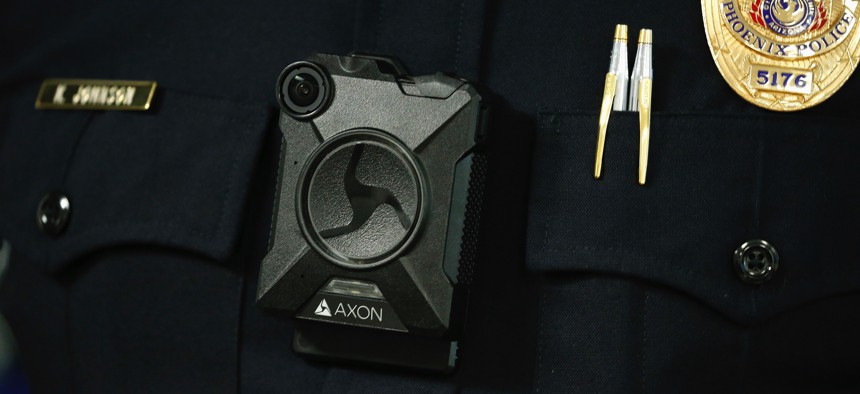
Phoenix Police Department Sgt. Kevin Johnson shows off the new Axon Body 2 body camera as another precinct gets their cameras assigned to them Wednesday, July 3, 2019, in Phoenix. AP / Ross D. Franklin
Federal Bill Would Constrain Some Police Use of Facial-Recognition Tools
A 72-hour limit on tracking individuals would become the first, and somewhat arbitrary, federal line in the sand.
Police would need a warrant to use facial-recognition tools to track an individual for more than three days under a proposed law that would place the first federal limits on law enforcement’s use of the technology.
The bill’s sponsors, Sen. Chris Coons, D-Delaware. and Mike Lee, R-Utah, say their Facial Recognition Technology Warrant Act would prevent the sorts of governmental abuses common in China and elsewhere.
Under the new law, a police officer could, for instance, run footage from her body camera device against a database of people with outstanding warrants and use facial recognition to find matches. But that officer would not be able to use networks of closed circuit cameras to track an individual for longer than three days.
The bill’s sponsors admit that the 72-hour limit is somewhat arbitrary. But they are seeking to strike a tricky balance between law enforcement groups that say facial recognition is a useful tool for solving and preventing crimes and privacy advocates who are pushing for more regulation or outright banning of the technology by police departments.
Related: CBP Reverses Course on Mandatory Facial Scans for US Citizens
Related: Facial Recognition is Changing CBP Operations
Related: Moscow to Weave AI Face Recognition into Its Urban Surveillance Net
China shows why limits are important, the senators said Thursday at a Brookings Institution event. That government uses facial-recognition and other technology to monitor dissidents and suppress public activism. Russia, too, has been weaving the tech into its surveillance nets in Moscow and other cities, aiming to help suppress dissent.
In the United States, courts have ruled that people can’t expect privacy when they appear in public. However, some rulings suggest the use of technology to track individuals can be regulated. In 2018’s Carpenter v. the United States, the Supreme Court ruled that police had violated the plaintiff’s Fourth Amendment right against unreasonable search and seizure when they obtained digital location data from his phone without a warrant. Another is 2012’s Jones v the United States, in which the government secretly placed a GPS tracker on the plaintiff’s car and followed him for a month. Both rulings held that the government runs a clear risk of violating Fourth Amendment rights when it uses technology to track people’s location without a warrant even if that tracking is occurring in public. Coons and Lee aim to curb specifically the use of facial recognition for this purpose.
The growth in facial recognition software for law enforcement in the United States is forecast to nearly triple from $136 million in 2018 to $375 million in 2025. Business forecaster IHS Insight predicts that the world will be watched by more than a billion surveillance cameras by 2021, nearly one-third more than today, thanks largely to China. A majority of Americans, about 56 percent, trust law enforcement to use the technology wisely. But examples of racial bias in the outputs of facial recognition searches, and other civil liberties concerns, have led some cities, such as San Francisco and, most recently Portland, to ban the technology.
Yet closed circuit camera footage is almost always of private property, owned by building managers or security companies. Right now, there are no laws that prohibit the way they collect image data on people in the public domain and there are no laws to prevent them from applying simple machine learning algorithms on that data to run their own tracking on individuals.




